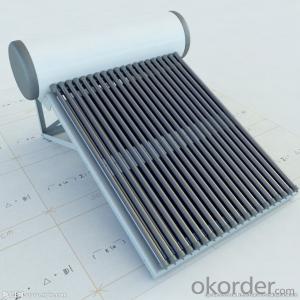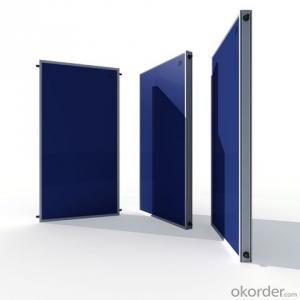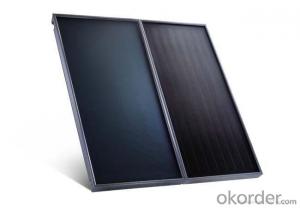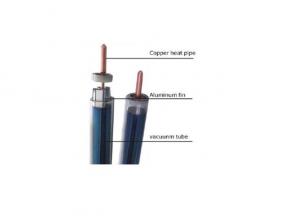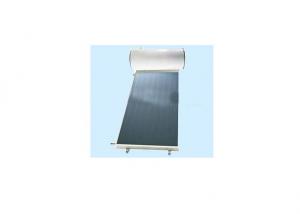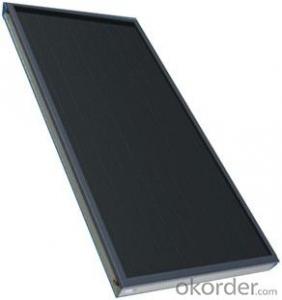Non-Pressurized Heat Pipe Solar Water Heater System
- Loading Port:
- China main port
- Payment Terms:
- TT OR LC
- Min Order Qty:
- 1 set
- Supply Capability:
- 6000 set/month
OKorder Service Pledge
OKorder Financial Service
You Might Also Like
Introduction of Non-Pressure Solar Water Heater:
Non-pressure Solar Heater is one of the most economical solar water heating device with pretty high efficiency at the same time. It consists of hot water storage tank, solar vacuum tubes with mouth plug in storage tank, and bracket supporting tank and tubes.When cold water in evacuated tubes is heated with solar irradiation, as the specific gravities of hot water and cold water are different, hotter water goes upward to storage tank and colder water goes downward to glass tubes. through this continuous circulation, the cold water in storage tank will be gradually heated till sunset.
Specialty:
1. High thermal performance and working temperature: the heat exchanging rate even in winter can up above 55%.
2. Heat collecting efficiency is at least 20% above common solar systems.
3. Work in all day and all season: no matter any corner of the world, this system can work well even -40℃ to avoid the tube freezing problem.
4. Reliability: No water following through the tube, so water scale can not generate and tube cracks could be avoided, the system still can keep working even with some damaged tubes.
5. It can connect with water tap and work automatically with pressure0.6Mpa, bring enjoyable washing experience.
6. Safety: P/T valve would release pressure and temperature to protect tank..
Technical Specification:
1. Outer tank material: SUS304 stainless steel or powder coated color steel
2. Inner tank material: 1.2mm thick SUS304 food grade stainless steel ( Optional material SUS316L)
3. Vacuum tube material: borosilicate glass 3.3; AL-SS-CU absorb coating, with copper heat pipe inside
4. Frame material: 1.2mm thickness stainless steel
5. Insulation material: 55mm thickness polyurethane
6. Suitable for mains pressure water(up to 8 bar/116psi)
7. Easy plug-in installation
8. Install the T/P valve on the pressurized tank
9. Seal material: Stabilized High Temperature Silicon
Outer tank material: SUS304 stainless steel or powder coated color steel
Inner tank material: 1.2mm thick SUS304 food grade stainless steel ( Optional material SUS316L)
Vacuum tube material: borosilicate glass 3.3; AL-SS-CU absorb coating, with copper heat pipe inside
Frame material: 1.2mm thickness stainless steel
Insulation material: 55mm thickness polyurethane
Suitable for mains pressure water(up to 8 bar/116psi)
Easy plug-in installation
Install the T/P valve on the pressurized tank
Seal material: Stabilized High Temperature Silicon
19. Vacuum Tube | 20. Size (mm) | 21. Φ47*1500 / Φ58*1800 / Φ70*2100 | |||||
22. Tube (pcs) | 23. 10 / 12 / 15 / 18 / 20 / 22 / 24 / 30 / 36 / 42 | ||||||
24. Material | 25. Borosilicate 3.3 glass, magnetron spluttering selective coating | ||||||
26. Coating | 27. Single-target AL-N/AL or Three-target AL/N-Cu-SS | ||||||
28. Water Tank | 29. Capacity | 30. 80L ~ 500L for hot water storage tank | |||||
31. Inner tank | 32. Food-grade stainless steel SUS304-2B / SUS316 | ||||||
33. Insulation | 34. High-density polyurethane foam with 70~80 hour heat preservation | ||||||
35. Tank shell | 36. Food-grade stainless steel SUS304-2B | ||||||
37. Bracket | 38. Shaped strong aluminum alloy structure adaptable for flat or slope roof | ||||||
39. Accessories | 40. Anti-aging silicon seals, Dustproof seals, Air-vent cap, Stainless screws | ||||||
41. Auxiliary Devices | 42. Assistant tank, Intelligent controller, Electrical heater, Magnesium anodes | ||||||
43. Tilt Angle | 44. 25 ~ 50° | ||||||
45. Water Output | 46. 45 - 95°C | ||||||
47. Hail Resistance | 48. Φ25mm diameter | ||||||
49. Model Number | 50. Solar Vacuum Tube | 51. Tank 52. Liter | 53. System 54. Liter | 55. Container Loading Qty /sets | |||
56. Size /mm | 57. Qty /pcs | 58. 20GP | 59. 40GP | 60. 40HQ | |||
61. VNS-58SA12-100 | 62. Φ58*1800 | 63. 12 | 64. 100 | 65. 132 | 66. 58 | 67. 119 | 68. 140 |
69. VNS-58SA15-130 | 70. 15 | 71. 130 | 72. 170 | 73. 54 | 74. 108 | 75. 131 | |
76. VNS-58SA18-150 | 77. 18 | 78. 150 | 79. 198 | 80. 43 | 81. 86 | 82. 105 | |
83. VNS-58SA20-170 | 84. 20 | 85. 170 | 86. 223 | 87. 40 | 88. 80 | 89. 97 | |
VNS-58SA24-200 | 24 | 200 | 263 | 35 | 70 | 85 | |
VNS-58SA30-250 | 30 | 250 | 329 | 28 | 56 | 68 | |
VNS-58SA36-300 | 36 | 300 | 395 | 23 | 47 | 57 | |
Product Show
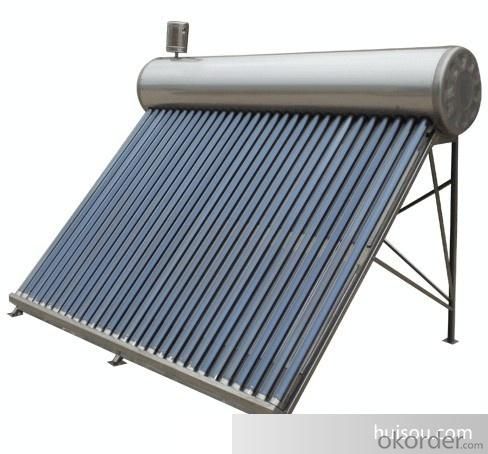
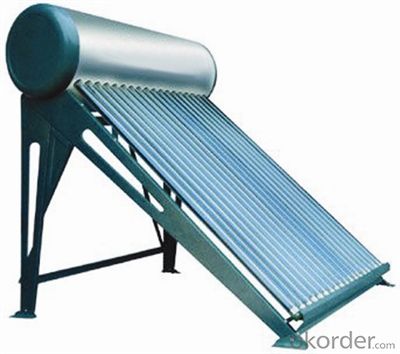
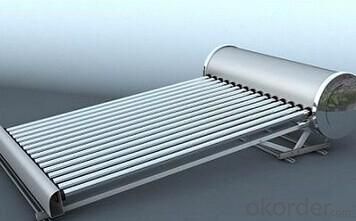
Our Services
1. OEM service
2. Warranty: 5 years
3. Considerable after sale service
Color steel Compact pressure Thermal solar heater
FAQ:
1. What’s the delivery time?
10 days after receiving deposit.
2. How long is the warranty?
5 years for whole system, 1 year for accessory
3. What’s your production capacity?
6000sets/month
4. What’s the MOQ?
1 set.
5. What’s your payment term?
Container: 30% T/T in advance for deposit, 70% T/T before shipment for fist order.
70% T/T after seeing copy of B/L from second order
Sample: 100% T/T in advance
Other choices: L/C at sight.
6. What certifications do you have?
CE, SOLAR KEYMARK, SRCC and etc.
- Q:Can solar collectors be used in industrial applications?
- Yes, solar collectors can be used in industrial applications. Solar collectors can provide a cost-effective and sustainable energy solution for various industrial processes, such as heating water, generating steam, or powering machinery. By harnessing solar energy, industrial facilities can reduce their reliance on fossil fuels, lower operating costs, and minimize their environmental impact.
- Q:Are solar collectors suitable for heating livestock barns?
- Yes, solar collectors are suitable for heating livestock barns. Solar collectors, such as solar water heaters or solar air heaters, can provide a sustainable and cost-effective solution for heating livestock barns. They utilize the sun's energy to generate heat, which can be used to warm up the barns during colder months. This can help maintain a comfortable temperature and create a healthier environment for the livestock, promoting their well-being and productivity. Additionally, solar collectors have low maintenance requirements and can be easily integrated into existing barn structures. Overall, using solar collectors for heating livestock barns can reduce energy costs, decrease reliance on fossil fuels, and contribute to a more sustainable agricultural system.
- Q:What is the environmental impact of solar collectors?
- Solar collectors have a positive environmental impact compared to other forms of energy generation. They produce clean, renewable energy by harnessing the sun's power, which significantly reduces greenhouse gas emissions and air pollution. However, the manufacturing process of solar collectors does have some environmental consequences, including the use of raw materials and energy. Nonetheless, the overall environmental footprint of solar collectors is much smaller than that of fossil fuel-based energy sources.
- Q:Can solar collectors be used for generating electricity on farms?
- Yes, solar collectors can be used for generating electricity on farms. Solar panels or collectors can be installed on rooftops or open areas in farms to capture sunlight and convert it into electricity through the photovoltaic effect. This clean and renewable energy source can help farmers reduce their reliance on fossil fuels, lower their electricity costs, and contribute to a more sustainable farming operation.
- Q:Can solar collectors be used in areas with limited access to training programs?
- Yes, solar collectors can be used in areas with limited access to training programs. While training programs can provide valuable knowledge and skills for optimizing the use of solar collectors, the basic principles of their installation and operation can still be learned through online resources, manuals, and guides. Additionally, local technicians or engineers can be trained specifically for solar collector installations, maintenance, and troubleshooting, ensuring their effective use in areas with limited training programs.
- Q:Can solar collectors be used in cloudy weather?
- Yes, solar collectors can still be used in cloudy weather. While the efficiency may be reduced, they can still generate electricity or heat by capturing diffuse sunlight.
- Q:How do solar collectors affect visual aesthetics?
- Visual aesthetics can be influenced by solar collectors in both positive and negative ways. On one hand, these collectors have the potential to enhance the appearance of a building or landscape. Their sleek and modern designs can add a futuristic and eco-friendly touch, making a property more visually appealing. Additionally, the sight of solar collectors producing clean energy can symbolize progress and sustainability, further enhancing the visual appeal of an area. On the other hand, some individuals may find the presence of solar collectors unattractive or disruptive to the overall aesthetic. The size and bulkiness of traditional solar panels can be considered an eyesore, especially for those who prefer a more traditional or minimalist design. Furthermore, their placement on rooftops or in open spaces may obstruct views and alter the natural landscape, negatively impacting visual aesthetics. It is worth noting, however, that advancements in solar technology have resulted in more visually pleasing options. Solar tiles or shingles, for instance, seamlessly blend with traditional roofing materials, maintaining the overall aesthetic of a building while still generating energy. Moreover, solar collectors can be strategically positioned or integrated into architectural designs to minimize their visual impact, making them more acceptable for those concerned with aesthetics. Ultimately, the effect of solar collectors on visual aesthetics will vary depending on personal preferences, the design and placement of the collectors, and the overall context in which they are installed. As solar technology continues to progress, there is an increasing focus on seamlessly incorporating renewable energy solutions into the built environment, finding a balance between functionality and visual appeal.
- Q:What materials are commonly used in solar collectors?
- Commonly used materials in solar collectors include glass, metal, plastic, and various types of absorber materials such as copper, aluminum, or stainless steel.
- Q:How do solar collectors affect the humidity levels in a building?
- Solar collectors do not directly affect the humidity levels in a building. However, they may indirectly impact humidity by reducing the need for conventional energy sources, such as fossil fuels, which can produce greenhouse gases that contribute to global warming. As a result, solar collectors can help mitigate climate change, which in turn can affect humidity patterns and levels over time.
- Q:Are solar collectors suitable for historic buildings?
- Yes, solar collectors can be suitable for historic buildings. While it is important to preserve the architectural integrity and historical value of these structures, solar collectors can be discreetly integrated into the design, ensuring minimal visual impact. With advancements in technology, there are now options available that blend well with the aesthetics of historic buildings, allowing them to harness clean energy without compromising their unique character. Additionally, solar collectors can provide a sustainable and cost-effective solution for powering historic buildings, helping to reduce their carbon footprint while preserving their historical significance.
1. Manufacturer Overview |
|
|---|---|
| Location | |
| Year Established | |
| Annual Output Value | |
| Main Markets | |
| Company Certifications | |
2. Manufacturer Certificates |
|
|---|---|
| a) Certification Name | |
| Range | |
| Reference | |
| Validity Period | |
3. Manufacturer Capability |
|
|---|---|
| a)Trade Capacity | |
| Nearest Port | |
| Export Percentage | |
| No.of Employees in Trade Department | |
| Language Spoken: | |
| b)Factory Information | |
| Factory Size: | |
| No. of Production Lines | |
| Contract Manufacturing | |
| Product Price Range | |
Send your message to us
Non-Pressurized Heat Pipe Solar Water Heater System
- Loading Port:
- China main port
- Payment Terms:
- TT OR LC
- Min Order Qty:
- 1 set
- Supply Capability:
- 6000 set/month
OKorder Service Pledge
OKorder Financial Service
Similar products
New products
Hot products
Hot Searches
Related keywords
